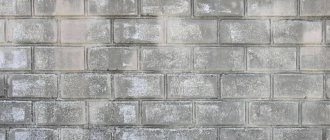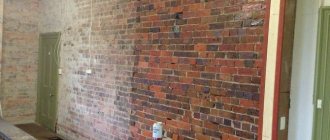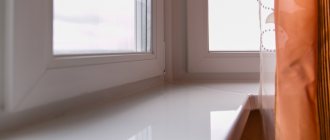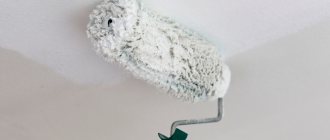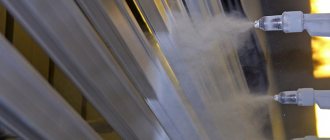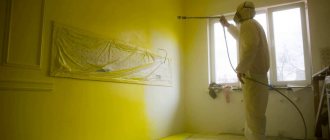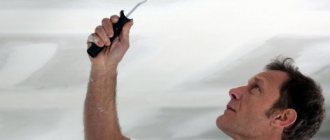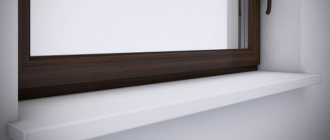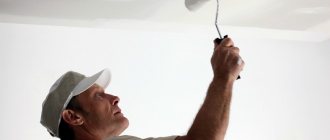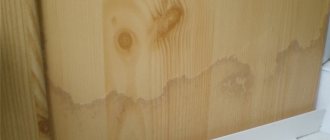What to consider before painting a brick wall
The decision to repaint a brick wall should be carefully considered. You need to understand that there will be no going back, since it is almost impossible to remove the applied paint without significant damage to the brick. The natural roughness and terracotta tint will be lost forever and any further color change can only be achieved by another repainting. Such procedures are inevitable in this case, since even the best painting materials tend to gradually fade and crumble.
Fireplace before and after painting bricks
Brick itself is a rather specific material. It is characterized by some porosity and vapor permeability. After production, a certain time must pass for the material to dry well and weather. Therefore, it is strictly not recommended to paint “fresh” brick walls: it is advisable to let them sit for several years . Otherwise, unsightly salt stains and wet spots may appear on the surface of the paint: this not only makes the painted wall unsightly, but also contributes to the rapid peeling of the paint layer.
Stains on a brick wall from improper painting
Painting a brick facade makes it possible not only to make it more attractive, but also creates additional protection from negative external influences. If everything is done correctly, the masonry will receive additional resistance to moisture, chemical and mechanical influences. In this case, much will depend on the correct selection of paint.
Consumption
To get a high-quality coating, you need to apply at least two (and sometimes three or four) layers of paint; each of them must dry completely. This consumption of material is due to the porous texture of the brick.
When calculating the amount of composition when purchasing, you can safely increase the numbers indicated on the label at least twice. On average, painting a plastered wall requires 0.5 liters of paint per 1 m2; to cover the same area of a brick wall you will need from 1 to 1.5 liters.
What types of paint are suitable for brick and how to choose them
All commercially available painting materials are divided into two large groups - façade and for interior use. The first category is characterized by greater resistance to moisture and temperature changes: facade paint can be used both outdoors and indoors.
Requirements for brick paint:
- Moisture resistance. This especially applies to situations where painting street brick walls is necessary. This will not be superfluous in cases where the interior in the kitchen, bath or hallway needs updating.
- Ability to pass steam. Most types of brick are vapor permeable, and if you create a “blind” layer on top of such a material, this will provoke the accumulation of condensation under the paint layer. As a result, the paint begins to peel off rapidly.
- Good hiding power. Elastic paints are best suited for decorating rough brick surfaces. Due to some plasticity, such a finish will not crack during seasonal or shrinkage deformations of the brick wall.
- Resistance to temperature fluctuations. This is especially true for the outer surfaces of a brick wall, which experience all the charm of climatic influences. Good heat resistance of brick paint will also be needed in cases where additional finishing of brick stoves and fireplaces is carried out.
In general, all paints used for painting brick can be water-based or organic.
Each of the compositions of this type has its own specific application:
- Nitroenamels, oil dyes. They are well absorbed into bricks and withstand sunlight and mechanical stress. However, after their application, a strong hydrophobic film is created on the surface of the material, completely clogging the structure. As a result, condensation begins to appear on the brick wall.
Nitroenamel is not the best choice for painting brick
Organic paints are not recommended for use in residential interiors , as this will provoke dampness of the walls and disruption of the internal microclimate. They are more suitable for decorating brick facades, fences and balconies.
- INsingle-dispersion. An excellent option for painting brick is water-based façade paints. They are presented in several varieties, each of which has specific characteristics. Liquid glass acts as a binder for silicate materials. The degree of their resistance to atmospheric influences is quite insignificant, which is reflected in a rather short service life - up to 3 years.
Water-dispersion paint is a good option for painting brick, but its service life is only 3 years
Acrylic facade compositions are much stronger and more reliable: after hardening, they can be dry cleaned. They also increase the ability of brickwork to withstand moisture.
However, the most suitable water-based brick paint option is acrylic-silicone solution , which can last up to 10-12 years. After drying, the material forms a vapor-permeable layer with good hydrophobic and vandal-proof characteristics. The cost of this paint is quite high, but the result obtained completely compensates for all costs.
Acrylic-silicone paint is one of the best options for painting brick
- Epoxy. The composition of this material may differ slightly: in some cases it contains toxic components, which should be checked with the seller. In general, all epoxy paints are characterized by good adhesion to brick and strength. To increase resistance to climatic influences, after the paint has hardened, it can be hidden with a layer of varnish.
Epoxy paint is durable and adheres well to brick
- Mineral . The basis of mineral paints is cement. They can be used to decorate brick facades, fences and balconies. After hardening, the coating resists moisture, temperature fluctuations and mechanical stress well. Typically, mineral dyes are used for exterior work.
Mineral paint is good for brick
- Silicone. An excellent option for very smooth brick walls with low adhesion. Basically, sand-lime brick has these characteristics. There is a line of heat-resistant silicone paints specifically for finishing stoves and fireplaces.
Silicone paint is perfect for sand-lime brick
Decoration
By modifying the wall, you can, however, preserve its interesting texture, while at the same time giving the space compositional completeness. Stone and brickwork are in demand in interiors today; the presence of a design element is considered a great advantage and does not require special decoration.
If desired, you can avoid painting and maintain the original appearance of the brickwork. To do this, the surface is treated with a special impregnation and colorless varnish. The procedure will ensure the strength and beautiful appearance of the brickwork.
However, the process of any finishing is not simple and requires certain knowledge and skills. Painting a wall is divided into several stages.
How to prepare the surface before painting
In addition to choosing the right paint, the quality and durability of the decorative layer largely depends on proper preparation.
List of necessary preliminary work before painting a brick wall:
- Cleaning. The brick wall must be thoroughly cleaned from traces of dirt, dust, particles of masonry mortar and old finishing (if any). All masonry seams must be carefully inspected to detect any fallen or dried mortar. All elements that have lost strength must be removed by filling the resulting voids with sand-cement mortar or silicone sealant. In the same way, all detected cracks must be eliminated. After the sealed areas have dried, they are sanded with sandpaper.
First, you need to repair all the cracks in the wall, and then sand everything with sandpaper.
- Removing efflorescence. For these purposes, a stiff brush and an aqueous solution of bleach (3:1) are usually used. There is a misconception that traces of salt on a brick can be successfully painted over: it should be noted that the effect of painting will not last long, and the salt deposit will appear on the decorative finish quite quickly.
To remove efflorescence, you need to apply a bleach solution, clean these areas with a stiff brush and rinse everything thoroughly with water.
- Fighting fungus and mold. If there are traces of fungus and mold, antiseptic treatment will also be required. Instead of expensive products, you can use regular “Whiteness”, diluting it in water 1:1. After treating the affected areas of the wall, you need to pause for 15-20 minutes, and then remove the mold with a scraper.
To combat mold and fungi, you can apply a solution of “Whiteness” to the wall, scrape everything off with a scraper, and then rinse thoroughly with water.
- Fighting greasy stains. Grease stains deserve special attention, as some types of paint simply will not stick to them. To neutralize grease on walls, special degreasers are used (for example, DOCKER).
Docker Degreaser
- General washing with soapy water. After the antiseptic has dried, the entire area of the brick wall to be painted should be washed with soapy water. After washing, the surface should dry well.
The wall must be washed with soapy water
- Primer. After allowing the prepared surface to dry for 5-7 days, it must be primed in 2 layers. The choice of a suitable primer composition depends on the specifics of the wall being prepared and its operating conditions. To increase the degree of adhesion of the surface to the paint, you can use conventional latex or acrylic impregnation: this will also reduce the consumption of paint material by an order of magnitude.
The final step in preparing a brick wall for painting is primer.
If the brick surface will be exposed to significant moisture, then it is best to prime it with Polyfluid: this waterproofing agent contains synthetic resins, which crystallize after penetrating deep into the brick. As a result, the capillaries become clogged and a completely waterproof barrier is formed. To apply the primer, a roller, brush or construction spray is usually used.
Polyfluid
Preparing the base
Initially, you should assess the condition of the wall. If there are chips, leveling using plaster is required. Before starting work, the base is cleaned of dust with a stiff brush. Afterwards, the masonry is washed with a cleaning mixture with foam and left to dry for about a week.
If there is concrete on the brick, then you need to get rid of it, and how to do this, watch the following video:
If the surface does not have rough irregularities, minor defects are masked with putty. After it dries, a primer is needed to protect it from the negative effects of moisture. If the wall surface is located in an unheated space, then it is treated with anti-fungal impregnation. The antifungal solution is odorless and colorless, and dries within 24 hours.
Brick painting tools
When choosing what exactly to apply paint to a brick wall, you need to take into account the degree of surface roughness and the type of decorative effect that you want to achieve:
- Brush. A convenient tool for painting brick, allowing you to feel the surface well and apply it evenly. In this case, it is more convenient to move along the masonry pattern. If acrylic paint is used, it is advisable to buy good quality polyester brushes. For alkyd and oil dyes, natural bristles are preferable. The most optimal size and shape of a brush for painting brick is a flat tool with a width of 70-100 mm. It is more convenient to paint corners with narrower brushes with obliquely cut bristles.
Brush for painting a brick wall
- Roller. An excellent option for applying the first starting layer of paint, since the brick surface usually quickly absorbs decorative solutions. For such work, foam rubber or wool tools with a medium length of pile are chosen. To paint a wall at a height, you can put a special extension rod on the handle.
Roller for painting a brick wall
- Spray gun. It is used for quickly painting flat sections of a large area of brick wall. This could be, for example, a brick fence or the facade of a building. To achieve a good decorative effect, the instrument must be tuned.
Spray gun for painting a brick wall
- Sponge. Used exclusively for creating indoor interiors. With its help you can get the effects of an old, sun-bleached coating. This is a good technique to whiten the masonry, achieving some transparency of the decorative layer. A sponge is especially convenient when painting raised areas, as it makes it possible to tint the entire depth of the rough texture. This coloring method is good for creating beautiful silver and bronze highlights. The surface may be given additional contrasting spots or stencil designs.
Sponge for painting bricks
In addition to the tool for directly applying paint to the brick, you will also need some additional equipment. Basically we are talking about protective clothing and gloves, as well as film and tape, which can be used to conveniently protect adjacent surfaces from being smeared.
How to paint a brick (brick wall)
For interior work, a roller or brush is usually used, but it is more convenient to paint facades with a construction spray gun (spray gun).
It is advisable to start from the top of the wall, from any of the corners. To apply the first layer, it is advisable to dilute the paint a little: water-soluble compositions are especially convenient in this regard, where it is enough to add a little water to the material and stir it thoroughly. If the work is carried out outdoors, then it is advisable to choose a dry, cool day for it: the optimal air temperature is +15 - +20 degrees.
As a rule, for high-quality painting of a brick surface, you will need to apply 2-3 layers. Before laying the next layer, you must wait until the previous one has completely dried. The most popular water-based formulations usually dry within 3-4 hours. As for decorating new brick walls, painting them is permitted no earlier than 1-2 years after completion of construction. During this period, the brickwork shrinks, weathers and leaches: if these processes take place under the paint layer, it will certainly begin to crack or become covered with whitish stains.
1 - apply paint in a convenient way (spray gun, brush or roller); 2 - wait until the paint is completely dry; 3 - Apply a second coat of paint.
If a brick wall needs to be given a monochromatic color, then problems with such decoration usually do not arise: all that is required is to choose a suitable application tool and take care of protecting adjacent surfaces from splashes. However, more complex types of finishing can be used indoors. For example, a mosaic made of multi-colored bricks is very popular when you need to use several paints of different tones at once.
A brick wall can be painted in several shades at once
Often, brick walls in the interior are given the effect of aging, matte or glossy shine. In each of these cases, you will need to use a specific application technique.
Artificial aging of brick
The easiest option to make a brick wall not just plain, but to decorate it in a special way is to use stencil images. Usually they carry a thematic load and are performed on top of a pre-applied monochromatic paint layer. The interior looks very interesting, where the brick walls are decorated with beautiful graffiti. Another option is to make the masonry seams bright and contrasting.
White mortar for filling brick wall joints
Caring for painted brick surfaces
Caring for a painted brick wall is very simple: it must be periodically wiped with a soapy solution using a sponge. If local damage or paint peeling is detected, simple restoration measures are carried out. To do this, you need to carefully clean off the exfoliated fragments using a scraper, then prime and carefully putty the resulting depression. After drying, the sealed area is lightly sanded and painted. To achieve complete invisibility of the repaired area, it is advisable to use paint from the same series as for the initial decoration.
In terms of labor costs, painting brickwork is much more profitable and easier than plastering or cladding. If everything is done correctly, a painted brick facade will perfectly retain its decorative qualities for at least 5 years (interior decoration usually lasts much longer).
How and how to paint a brick (brick wall)
Brick Paint Spray gun Painting repair DIY walls
Visual effects
Brickwork is a fashionable decorative element that is often used in interior design. Little professional tricks and techniques will help you make the surface look finished and stylish.
For example, a smooth wall made of bricks can look attractive even without a paint coating if you treat it with clinker oil or acrylic-based parquet aqualac.
The technology of ordinary dyeing can be diversified in the following ways:
- paint the seams in a contrasting tone;
- Apply a thin layer of paint with a mother-of-pearl, bronze or silver effect onto the dried base-color coating with a sponge;
- decorate a wall using stencils;
- make a stylish inscription;
- draw with a thin brush;
- paint each brick alternating two or more colors.
To decorate brick walls and smooth surfaces, similar techniques are used and similar materials and devices are used. No special skills are required for this, so you can do it yourself.
Painting brick walls is a rather time-consuming process, but this finishing method has honestly earned its popularity.
